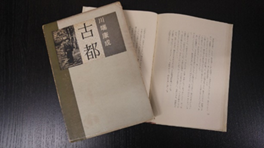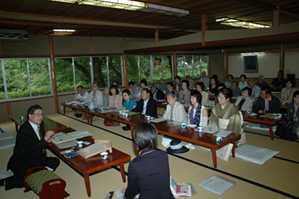The Mind of Kyoto
Yoshie Doi
 First edition of “Koto” published on June 25, 1962, retail price 350 yen |
 Kyoto, the Kyoto that Yasunari Kawabata loved – A Love Story of Kyoto Opening Lecture 2008 Lecturer: Professor Kaori Kawabata, Kawabata Kiyoshinari Memorial Foundation Chairman, Professor Emeritus, University of Tokyo |
On February 20, 2006, the Kyoto Shimbun newspaper published an article titled “The Mind of Kyoto” in which Kawai Toshio, then Commissioner-General of the Agency for Cultural Affairs, wrote his impressions of the film “Futari Biyori.”
“Since ancient times, Japanese people have not made a distinction between ‘things’ and ‘mind.’ The sparkle on the surface of the river, the sunlight filtering through the trees, and even kimonos all have ‘mind.’ This feeling is well conveyed throughout the film, and it conveys the ‘Mind of Kyoto.'”
In 2005, when we welcomed Professor Hayao Kawai to the Kyo-Suzume School “Earth and Mind Compilation,” he showed us a five-minute summary of a film starring Kyo-Suzume member Akira Kurizuka. He promised to “definitely come and see the film” the following winter.
On the day, Professor Kawai wiped away tears many times and seemed to be deeply moved. When I gave a presentation on cultural tourism practice at the Ministry of Land, Infrastructure, Transport and Tourism’s cultural tourism conference in 2004, Professor Kawai Hayao was one of the members and listened to my humble presentation.
After the event, he gave me some advice and praised the work of Kyo- Suzume. When I asked him to be the head of the judging committee for the Kyoto Love Letter competition and handed him the application documents, he said, “As I cannot appoint a private sector leader while I am the Commissioner for Cultural Affairs, I will accept the position of head of the judging committee after I leave my position as Commissioner for Cultural Affairs,” and put the application form in his suit pocket.
Unfortunately, he passed away after that, and his appointment as the chairman of the Love Letters judging committee did not come to fruition. However, Kawabata Kaori, the chairman of the Kawabata Yasunari Memorial Foundation, came to Kyoto from Kamakura many times and worked hard as the chairman of the “Love Letters to Kyoto” judging committee from the first to the second rounds. He was hospitalized due to illness and was unable to attend the judging, so the current chairman of the judging committee, Inoue Shoichi, has been working hard as chairman of the Love Letters judging committee since the third round.
Professor Inoue Shoichi also participated as a judge from the first open call for entries, and there were times when he expressed opinions that were completely opposite to those of Professor Kawabata, but as they exchanged opinions, they somehow came to a consensus and the judging ended with everyone being satisfied.
After the war, the year the atomic bomb was dropped on August 6th, a typhoon hit Hiroshima and the city was completely destroyed by mudslides. In 1948, Professor Yasunari became the president of the Japan PEN Club and visited Hiroshima several times. He served as the president of the Japan PEN Club for 18 years, and Professor Kaori told me that Professor Yasunari’s thoughts were, “Can literature make people happy? Can literature contribute to peace?” He devoted himself to writing in order to convey the good things about Japan.
The first edition of “The Ancient Capital” has a monotone binding, which seems to represent the city of Kyoto. The city of Kyoto is monotone, with its vermilion torii gates, the waterside of the Kamo River and Katsura River, and the greenery of the Higashiyama and Nishiyama mountains, which are very pleasant to look at. Professor Yasunari’s thoughts were conveyed in his Nobel Prize acceptance speech “My Beautiful Japan”, where he said, “When we die, nothing remains, but nature remains as it is. How can we preserve this beautiful Japan and hand it over to future generations? I believe this was Kawabata Yasunari’s challenge.” (Kyo-Suzume School: Kyoto Love Story, The Kyoto that Kawabata Yasunari Loved, 2008)
When asked at a press conference after receiving the Order of Culture during the Asahi Shimbun serialization, he said, “Why did you set the story in Kyoto?” “I wanted to write about the things that are gradually disappearing, even in this ancient capital. I come to Kyoto often, but I only see the famous places and historical sites from the outside. It’s as if I knew nothing about life inside.”
The Swedish Academy’s Nobel Prize evaluation (released in January 2017) states that “Kyoto” beautifully expresses the Japanese way of life, and vividly depicts the ethics, aesthetic sense, and people of Japan without Western influence. The fact that it was released for the first time in January 2017 after 50 years of secrecy shows how highly praised “Kyoto” was.
I made the film “The Ancient Capital” as a way of giving back to Professor Yasunari. As a producer, I selected the locations. From Oike to Gojo on Muromachi Street, I went to many Kyoto machiya houses to ask if I could use them as a location. The owners of the houses told me, “During the bubble period, it was thought that the best thing to do would be to demolish the houses and build buildings, but after learning about the European examples, I realized it was important to leave them as they were, and I’m glad I did.”
I strongly believe that Kyoto, which maintains traditional values while fusing with cutting-edge industry, will play a role as a model case for the future of cities.
I am truly happy to have had the opportunity to receive guidance from such teachers who know the heart of Kyoto as Yasunari Kawabata, Hayao Kawai, and Kaori Kawabata. The Kyoto Love Letter Competition is also a great opportunity to experience the heart of Kyoto. Please apply.
The end of document
Translated by Masami Otani
